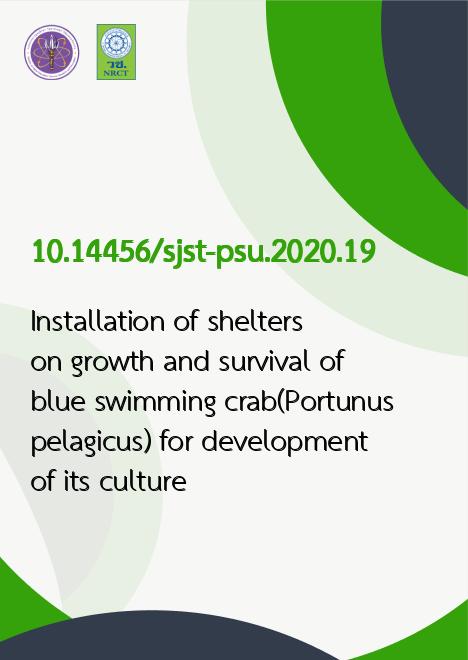
|
Installation of shelters on growth and survival of blue swimming crab(Portunus pelagicus) for development of its culture |
|---|---|
| รหัสดีโอไอ | |
| Creator | 1. Vutthichai Oniam 2. Wara Taparhudee 3. Ruangvit Yoonpundh |
| Title | Installation of shelters on growth and survival of blue swimming crab(Portunus pelagicus) for development of its culture |
| Publisher | Research and Development Office, Prince of Songkla University |
| Publication Year | 2563 |
| Journal Title | Songklanakarin Journal of Science and Technology |
| Journal Vol. | 42 |
| Journal No. | 1 |
| Page no. | 139-145 |
| Keyword | Portunus pelagicus, cannibalism, shelter |
| URL Website | https://rdo.psu.ac.th/sjstweb/index.php |
| ISSN | 0125-3395 |
| Abstract | The objectives of this study were to conduct experiments involving the rearing of the blue swimming crab Portunuspelagicus with four different types of shelters in concrete tanks: 1) 90? bent plastic plates; 2) concrete blocks; 3) PVC pipes; and4) stems of coconut leaves. We aimed to find which methods promote growth and improve the survival of the crabs using theshelters. The results showed that the type of shelter affected the survival rate of the crabs, while the presence of these shelters inthe tanks did not have any significant effect on its growth. The survival rates (mean?SD) of the crabs reared in the tanks with thestems of coconut leaves (82.2?7.7%) and 90? bent plastic plates (80.0?6.7%) were significantly higher than those using PVCpipes (66.7?6.7%) and concrete blocks (62.2?3.8%) as shelters. The differences of the effects of these four types of shelters onthe survival of the crabs seem to reflect the available space provided by them to escape cannibalism. The rearing experiments ofthe crabs with different densities of 90? bent plastic plates as shelters (0, 1, 3, and 5 shelters/m2) showed a significant increases inthe survival rates of crabs reared for 30 to 60 days (5 shelters/m2 71.1?3.8%, 3 shelters/m2 77.8?7.7%, 1 shelter/m2 62.2?3.8%,no shelter 48.9?3.8%), but the effect of the shelter on the improvement of the survival rate was less clear in the crabs reared for60 to 90 days. |
